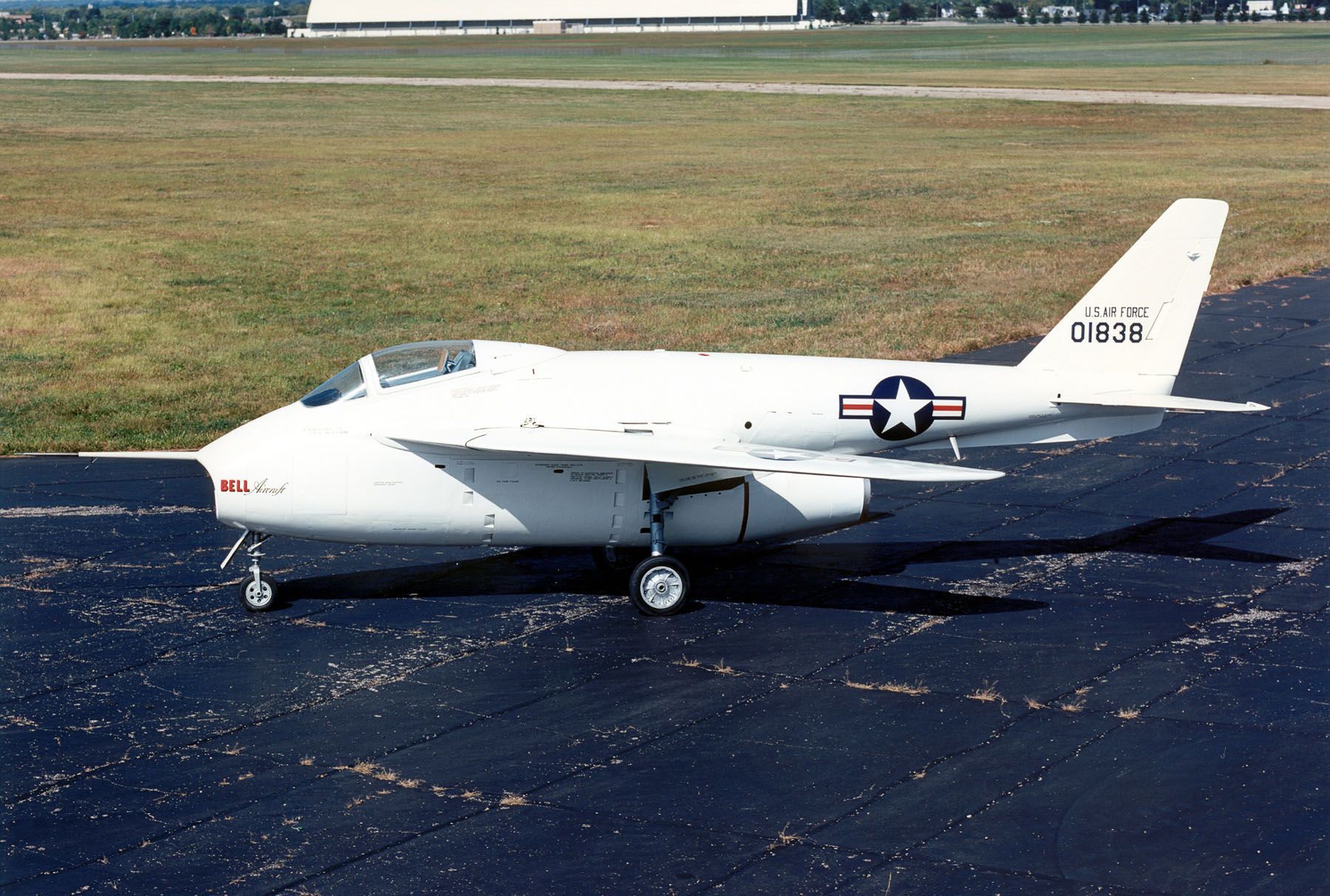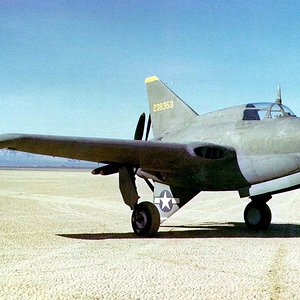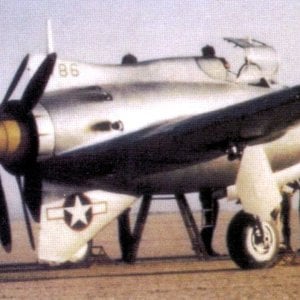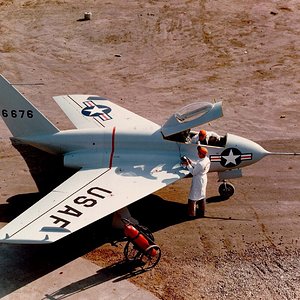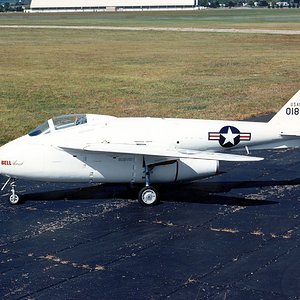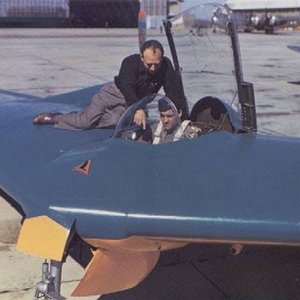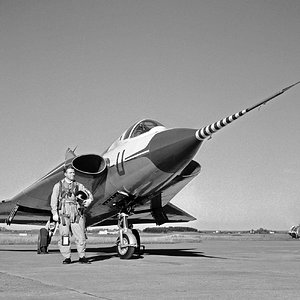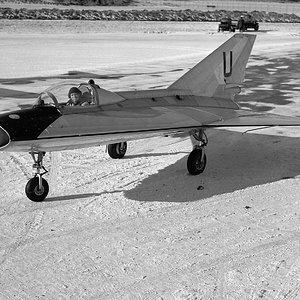Navigation
Install the app
How to install the app on iOS
Follow along with the video below to see how to install our site as a web app on your home screen.
Note: This feature may not be available in some browsers.
More options
You are using an out of date browser. It may not display this or other websites correctly.
You should upgrade or use an alternative browser.
You should upgrade or use an alternative browser.
Design and development
The incomplete Messerschmitt P.1101 fighter prototype recovered by United States troops in 1945 from the experimental facility at Oberammergau, Germany, was brought back to the United States. Although damaged in transit, the innovative fighter prototype was delivered to the Bell factory at Buffalo, New York where company engineering staff studied the design closely and led by Chief Designer Robert J. Wood, submitted a proposal for a similar design.[1]
Although superficially similar, the X-5 was much more complex than the P.1101, with three sweep positions: 20°, 40° and 60°, creating an in-flight "variable-geometry" platform. A jackscrew assembly moved the wing's hinge along a set of short horizontal rails, using disc brakes to lock the wing into its inflight positions. Moving from full extension to full sweep took less than 30 seconds. The articulation of the hinge and pivots partly compensated for the shifts in center of gravity and center of pressure as the wings moved.
Even so, the X-5 had vicious spin characteristics arising from the aircraft's flawed aerodynamic layout, particularly a poorly positioned tail and vertical stabilizer, which in some wing positions, could lead to an irrecoverable spin. This violent stall-spin instability would eventually cause the destruction of the second aircraft and the death of its Air Force test pilot in 1953.[2]
The unfavorable spin characteristics also led to the cancellation of tentative plans by the United States Air Force (USAF) to modify the X-5's design into a low-cost tactical fighter for NATO and other foreign countries.[3]
Specifications (Bell X-5)
General characteristics
Crew: 1
Length: 33 ft 4 in (10.1 m)
Wingspan:
Unswept: 33 ft 6 in (10.2 m)
60° sweep: 20 ft 10 in (6.5 m)
Height: 12 ft (3.6 m)
Wing area: 175 sq. ft. (16.26 m².)
Empty weight: 6,336 lb (2,880 kg)
Max. takeoff weight: 9,980 lb (4,536 kg)
Powerplant: 1 × Allison J35-A-17 turbojet, 4,900 lbf (21.8 kN)
Performance
Maximum speed: 716 mph (1,150 km/h)
Range: 750 mi (1,207 km)
Service ceiling: 49,900 ft (15,200 m)
Thrust/weight: 0.50:1
The incomplete Messerschmitt P.1101 fighter prototype recovered by United States troops in 1945 from the experimental facility at Oberammergau, Germany, was brought back to the United States. Although damaged in transit, the innovative fighter prototype was delivered to the Bell factory at Buffalo, New York where company engineering staff studied the design closely and led by Chief Designer Robert J. Wood, submitted a proposal for a similar design.[1]
Although superficially similar, the X-5 was much more complex than the P.1101, with three sweep positions: 20°, 40° and 60°, creating an in-flight "variable-geometry" platform. A jackscrew assembly moved the wing's hinge along a set of short horizontal rails, using disc brakes to lock the wing into its inflight positions. Moving from full extension to full sweep took less than 30 seconds. The articulation of the hinge and pivots partly compensated for the shifts in center of gravity and center of pressure as the wings moved.
Even so, the X-5 had vicious spin characteristics arising from the aircraft's flawed aerodynamic layout, particularly a poorly positioned tail and vertical stabilizer, which in some wing positions, could lead to an irrecoverable spin. This violent stall-spin instability would eventually cause the destruction of the second aircraft and the death of its Air Force test pilot in 1953.[2]
The unfavorable spin characteristics also led to the cancellation of tentative plans by the United States Air Force (USAF) to modify the X-5's design into a low-cost tactical fighter for NATO and other foreign countries.[3]
Specifications (Bell X-5)
General characteristics
Crew: 1
Length: 33 ft 4 in (10.1 m)
Wingspan:
Unswept: 33 ft 6 in (10.2 m)
60° sweep: 20 ft 10 in (6.5 m)
Height: 12 ft (3.6 m)
Wing area: 175 sq. ft. (16.26 m².)
Empty weight: 6,336 lb (2,880 kg)
Max. takeoff weight: 9,980 lb (4,536 kg)
Powerplant: 1 × Allison J35-A-17 turbojet, 4,900 lbf (21.8 kN)
Performance
Maximum speed: 716 mph (1,150 km/h)
Range: 750 mi (1,207 km)
Service ceiling: 49,900 ft (15,200 m)
Thrust/weight: 0.50:1

